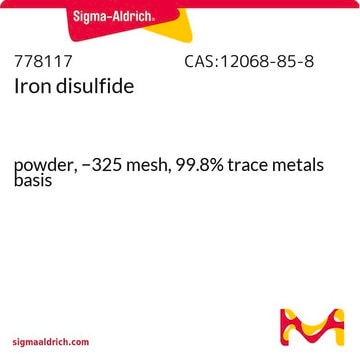343161
Iron(II) sulfide
−100 mesh, 99.9% trace metals basis
Sinonimo/i:
Ferrous sulfide
Scegli un formato
Scegli un formato
About This Item
Prodotti consigliati
Livello qualitativo
Saggio
99.9% trace metals basis
Stato
powder
Impiego in reazioni chimiche
reagent type: catalyst
core: iron
Dimensione particelle
−100 mesh
Densità
4.84 g/mL at 25 °C (lit.)
Stringa SMILE
S=[Fe]
InChI
1S/Fe.S
MBMLMWLHJBBADN-UHFFFAOYSA-N
Cerchi prodotti simili? Visita Guida al confronto tra prodotti
Applicazioni
- Progress in bioleaching: fundamentals and mechanisms of microbial metal sulfide oxidation - part A: This study delves into the microbial oxidation of metal sulfides like Iron(II) sulfide, shedding light on bioleaching processes crucial for the extraction of valuable metals from ores, which is highly relevant for environmental and materials science applications (Vera et al., 2022).
- Novel QTL Associated with Aerenchyma-Mediated Radial Oxygen Loss (ROL) in Rice: Explores genetic traits influenced by conditions such as the presence of Iron(II) sulfide in paddy fields, providing insights into how rice adapts to iron-rich anaerobic soils, which is vital for agricultural biotechnology and crop science (Duyen et al., 2022).
- Fe(ii) and Fe(iii) dithiocarbamate complexes as single source precursors: Investigates the synthesis of nanoscale iron sulfides from these precursors, using in situ X-ray absorption spectroscopy, which is essential for developing advanced materials with specific magnetic and electronic properties (Roffey et al., 2019).
Codice della classe di stoccaggio
11 - Combustible Solids
Classe di pericolosità dell'acqua (WGK)
WGK 3
Punto d’infiammabilità (°F)
Not applicable
Punto d’infiammabilità (°C)
Not applicable
Scegli una delle versioni più recenti:
Possiedi già questo prodotto?
I documenti relativi ai prodotti acquistati recentemente sono disponibili nell’Archivio dei documenti.
I clienti hanno visto anche
Active Filters
Il team dei nostri ricercatori vanta grande esperienza in tutte le aree della ricerca quali Life Science, scienza dei materiali, sintesi chimica, cromatografia, discipline analitiche, ecc..
Contatta l'Assistenza Tecnica.










